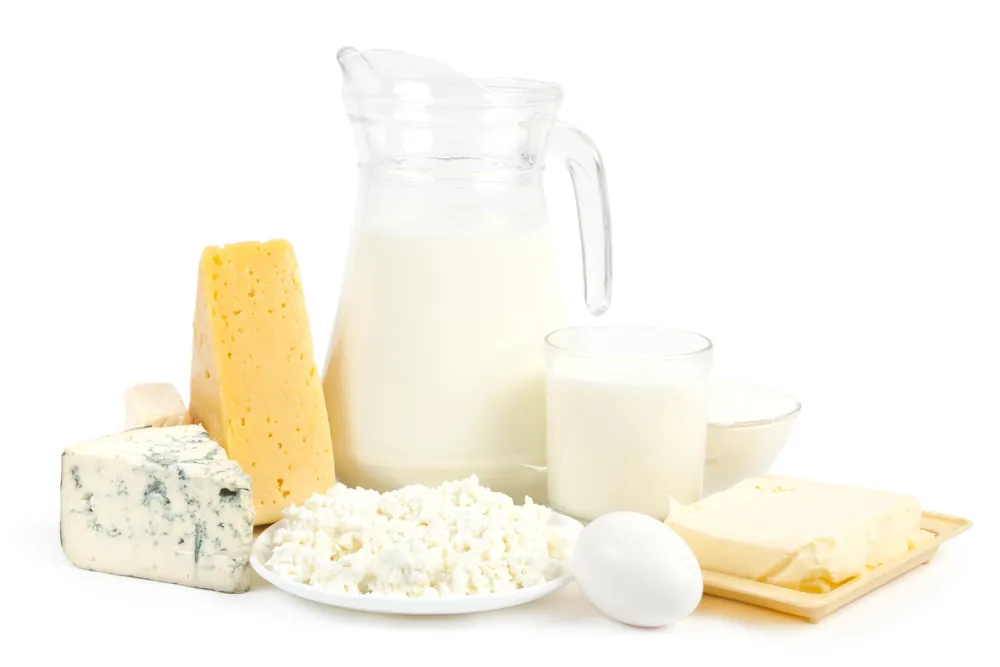
Shipping Dairy Products
When shipping dairy products, it's important to prioritize proper packaging, temperature control, and compliance with regulations so cargo can be shipped effectively and customers receive them fresh.
Can Dairy Products Be Shipped?
Shipping dairy products through freight is a common practice in the food industry that requires careful planning and strict guidelines to ensure the products remain fresh and maintain quality. From milk and cheese to butter and yogurt, these perishable goods demand specialized handling and temperature-controlled environments throughout transportation.
We believe that FreightCenter is the ideal company to consider when shipping dairy products; with our expertise, extensive carrier network, reliable delivery services, and outstanding customer support, you can trust that your dairy products will be handled with the utmost care and delivered efficiently and safely to their destination.

Choosing the Right Freight Company to Ship Dairy Products
Choosing the right freight company to ship dairy products is crucial for your goods’ safety and timely delivery. This requires careful consideration of their specialization in handling perishable goods, the availability of refrigerated carriers, a reliable track record, broad coverage area, provides adequate insurance coverage, competitive prices, and excellent customer service.
At FreightCenter, we possess extensive experience and knowledge in handling perishable goods, including dairy products. We understand the unique requirements and regulations of shipping these sensitive items and can provide invaluable expertise and guidance throughout the shipping process.
Choosing the Right Transportation Method to Ship Dairy Products
To maintain the freshness and quality of dairy products, choosing the best transportation method for your specific shipment is important. Before deciding which transportation method to ship your products, you should consider factors such as distance, transit time, temperature control, packaging requirements, regulatory compliance, and cost. Several transportation methods are available for shipping dairy products, each with advantages and considerations such as cost, transit time, temperature control, and handling requirements.
Air, sea, and ground freight are the most commonly used transportation modes.
- Ground freight uses refrigerated trucks shipping dairy products. These trucks have built-in temperature-controlled units that maintain a consistent and controlled environment during transit. They are suitable for both short and long distances.
- Air freight is a viable option when speed is crucial or when shipping dairy products to international destinations. Airlines have specialized cargo compartments with temperature-controlled units to maintain the required temperature range.
- Ocean freight utilizes refrigerated containers for shipping dairy products through ocean freight. These containers provide temperature-controlled environments and are loaded onto cargo ships. They are suitable for large-scale shipments over long distances.
Necessary Documents to Ship Dairy Products
When shipping dairy products, several documents are typically required to comply with regulations and ensure smooth transportation. The specific documentation may vary based on the destination country and transportation mode but are vital for import and export requirements., ensuring transparency and accountability, mitigating risks, and facilitating efficient and secure transportation. At FreightCenter, we can help you with your documentation services and ensure you have all the necessary forms for your shipment.
The most common documents involved with shipping dairy products are a Commercial Invoice, Packing List, Bill of Lading, Certificate of Origin, Health Certificate, Sanitary or Phytosanitary Certificates, Import/Export Licenses, and Insurance Documents. It is essential to consult with the chosen freight carrier to determine the exact documentation requirements for shipping dairy products. Having the proper documentation in order can facilitate the safe and compliant transportation of dairy products while meeting legal and regulatory obligations.
How to Prepare Dairy Products for Transportation
It’s important to properly prepare dairy products for transportation to maintain their quality and prevent spoilage or contamination. It’s a good idea to consult with industry experts specializing in dairy product transportation for specific guidance based on your product type, origin, and destination. Here are a few general steps to prepare dairy products for compliant delivery to their intended destination.
- Choose appropriate packaging materials suitable for dairy products and provide adequate protection. Use food-grade packaging materials that are clean, sturdy, and moisture-resistant. Consider using packaging designed explicitly for dairy products.
- Dairy products are often perishable and sensitive to temperature changes. Ensure proper temperature control throughout the transportation process. Use refrigerated or insulated packaging with ice packs or dry ice to maintain the desired temperature range if required.
- Clearly label the packages with relevant information, including the product name, quantity, lot number, and special handling instructions. Use waterproof and durable labels to prevent damage during transportation.
- Make sure that all containers or packages are securely sealed to prevent leakage or contamination. Use appropriate sealing methods, such as heat-sealing or tamper-evident seals.
When loading dairy products onto pallets or into containers, follow proper stacking and palletizing techniques. Stack products securely and evenly to prevent shifting or toppling during transportation.
Regulations and Standards for Shipping Dairy Products
Specific regulations for shipping dairy products will vary depending on their destination. It is essential to thoroughly research and understand the rules and standards for transporting dairy products in your specific region or country. Compliance with these regulations helps protect the environment and the integrity of the shipment.
Key standards and regulations involved with shipping dairy products to be aware of are Food Safety Regulations that govern their production, processing, packaging, and transportation. Import and Export Regulations for documentation, labeling, customs clearance, and compliance with specific import or export permits. Labeling and Packaging Standards to provide consumers with essential information about the product. Microbiological Standards that define acceptable limits for various microorganisms. Cold Chain Management to maintain their quality and freshness. Veterinary and Health Certifications that confirm the products meet certain health and safety standards. International Dairy Standards establish international standards and guidelines for the dairy industry.
How Much Does it Cost to Ship Dairy Products?
The cost of shipping dairy products can vary depending on various factors, such as the distance of the shipment, the type of dairy products being shipped, the shipping method, and any additional services required. Additionally, shipping costs may change over time due to fluctuations in fuel prices and other factors. To obtain accurate and up-to-date information regarding the specific cost of shipping dairy products. It is recommended to contact a freight broker, like FreightCenter, directly to provide detailed quotes based on your particular requirements and circumstances. Information about the shipment’s weight, dimensions, origin, and destination will help obtain more accurate cost estimates.


Shipping Dairy Products in 5 Simple Steps
- Packaging and Insulation: Select appropriate packaging materials designed specifically for shipping perishable dairy products. Insulated containers or coolers with ice packs or dry ice are encouraged to help maintain the desired temperature throughout shipping.
- Temperature Control: Maintain the required temperature range for dairy products during transportation. Depending on the specific product, this may involve refrigerated trucks, temperature-controlled containers, or expedited shipping options to guarantee freshness and prevent spoilage.
- Compliance with Regulations: Ensure compliance with all relevant regulations and documentation requirements for shipping dairy products. This includes obtaining necessary permits, licenses, and certifications and adhering to health and safety standards set by local, national, and international authorities.
- Proper Labeling and Documentation: Clearly label the packaging with appropriate product information, including the nature of the dairy product, batch/lot numbers, expiration dates, and any required warning labels. Prepare and include all the necessary shipping documents, such as invoices, certificates of origin, and health certificates.
- Carrier Selection and Booking: Choose a reliable shipping carrier specializing in handling perishable goods and has experience shipping dairy products. Request a quote and book your shipment, ensuring the carrier has the equipment, facilities, and expertise to maintain the required temperature and safely handle dairy products.
Shipping Dairy Products with FreightCenter
FreightCenter offers a range of shipping services to transport dairy products safely and efficiently, including ground, air, and ocean transportation. Preparing dairy products for transport is vital, as choosing the right freight company and transportation method and ensuring you have the necessary documents and following regulations. The cost of shipping dairy products can vary, but comparing carrier quotes can help find the most cost-effective option.

